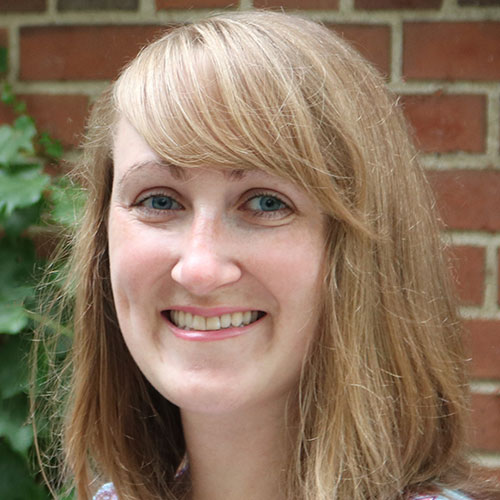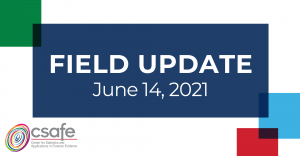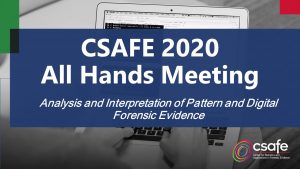Overarching GOALS
CSAFE is committed to leveraging statistical methods developed in one field of application for use in forensic science, as appropriate. Through research methods, CSAFE professionals are assessing reliability of categorical conclusions, investigations of properties of machine learning algorithms, and studies of score-based likelihood ratios to inform multiple domains.
Looking for
WEBINARS,
Short courses, presentations or publications
on Statistics?
Additional Team Members
Naomi Kaplan-Damry nkapland@uci.edu
Alicia Carriquiry
alicia@iastate.edu
Steve Lund (NIST)
steven.lund@nist.gov
focus Areas
CSAFE researchers are using traditional logistic models to study the performance characteristics of individual examiners and individual examples, as well as aggregate performance characteristics for the population. We are aiming to learn about the efficiency of individual examiners and about the population of examiners.
In many forensic science disciplines, especially those involving pattern comparisons, the most common approach to analysis of the evidence involves a series of binary or categorical decisions regarding the evidence. For example, in latent print analysis an examiner initially decides about whether the latent print has enough information to make a formal identification, or not enough value (i.e., there is not enough information to perform the comparison). Following this, assuming the print is of value, the examiner will reach a final decision that is again expressed in categorical terms (e.g., identification, inconclusive, exclusion). There is currently considerable discussion about the role of likelihood ratios in the analysis of forensic evidence. The ENFSI guidelines endorse this approach. Ongoing discussion about the next steps in forensic pattern evidence analysis in the United States however suggests maintaining the focus on categorical outcomes, with perhaps more potential outcomes allowed (a 5-point or larger scale). To date evaluations of forensic examiners have focused primarily on binary decisions (did they correctly identify a pair of known matching items?). There is a need for developing statistical approaches to reliability and validity studies using categorical scales.
The presumed setup for this research project is that data has been collected from a number of forensic science examiners on a number of cases or examples. For each examiner–example pair we have the outcome of the analysis (e.g., determination of value, conclusion with respect to source) on a categorical scale. There may also be data available about characteristics of the examiners and about characteristics of the examples. As a starting point for the research we will consider analyses treating each category as a binary response. This would, for example, in the latent print case, correspond to studying the probability of a VID (value for identification) decision (yes/no) and assessing variation in the decision-making process across examiners and examples. This can be done with traditional logistic models or with the closely related item response theory models used in educational testing. Using such models allows one to obtain information about the performance characteristics of individual examiners (and individual examples) as well as aggregate performance characteristics for the population. The next stage of the analysis will consider generalizations of these models to handle the multiple-category variables. This will focus on multinomial models, including those developed by considering underlying latent continuous variables. The aim of these models, like those described above, is to learn about the efficiency of individual examiners and about the population of examiners.
The primary goals of the proposed project are to (1) explore the strengths and weaknesses of score-based likelihood ratios (SLRs) for quantifying the value of evidence from a statistical perspective, (2) explore the strengths and weaknesses of SLRs from the perspective of forensic evidence interpretation, and (3) determine whether it is possible to develop a framework of evidence interpretation which exploits the strengths of SLRs for impression and pattern evidence. This project would greatly benefit the forensic science community by providing those who wish to use SLRs with a list of recognized strengths and weaknesses, with supporting reasons, as well as a framework for expressing conclusions regarding the SLR results.
Score-based likelihood ratios (SLRs) are becoming increasingly popular for analyzing impression and pattern evidence due to the inherent difficulties in computing Bayes Factors. Some researchers have argued against the use of SLRs within a Bayesian decision paradigm for philosophical reasons, often citing a lack of coherence. Additionally, these researchers might argue that SLRs don’t actually approximate a Bayes Factor, and worse still, there is no indication of how far an SLR may be from the corresponding Bayes Factor. Other researchers have argued that there is no issue with using score-based likelihood ratios in a Bayesian decision paradigm as long as that SLR is accompanied by a measure of calibration of the SLR system. Regardless of which viewpoint one takes, the fact remains that very little research has been published on whether or not SLRs have any validity for quantifying the value of forensic evidence. The primary goals of the proposed project are to (1) explore the strengths and weaknesses of SLRs for quantifying the value of evidence from a statistical perspective, (2) explore the strengths and weaknesses of SLRs from the perspective of forensic evidence interpretation, and (3) determine whether it is possible to develop a framework of evidence interpretation which exploits the strengths of SLRs for impression and pattern evidence. Many forensic science researchers and practitioners have a strong desire for quantitative results for impression and pattern evidence to bolster their “subjective” opinions. This project would greatly benefit the forensic science community by providing those who wish to use SLRs with a list of recognized strengths and weaknesses, with supporting reasons, as well as a framework for expressing conclusions regarding the SLR results.
The primary goals of this project are to (1) explore the extent to which violating the assumption of independence affects the performance of the scoring methods and (2) develop machine learning methods for evaluating comparison scores for forensic evidence which can accommodate and/or adjust for the dependency in the data. The proposed research will impact the community by providing more statistically rigorous methods of computing score-based likelihood ratios for impression and pattern evidence.
Pattern and impression evidence results in data that is inherently high-dimensional and difficult to model statistically. Therefore, many researchers have focused on methods of measuring the similarity between two objects instead. This comparison results in a low-dimensional score which is much easier to model. CSAFE researchers have relied on statistical machine learning algorithms to compute the scores. One of the difficulties with these methods is that the pairwise comparison of all the evidential objects results in a set of dependent scores. This is because any of the scores that contain the same object as one of the two in the comparison will be dependent. The difficulty lies in the fact that while machine learning methods do not have any distributional assumptions, most assume independence between the observations in the data. The primary goals of this project are to (1) explore the extent to which violating the assumption of independence affects the performance of the scoring methods and (2) develop machine learning methods for evaluating comparison scores for forensic evidence that can accommodate and/or adjust for the dependency in the data. The proposed research will impact the community by providing more statistically rigorous methods of computing score-based likelihood ratios for impression and pattern evidence. This project builds on the work achieved during the first five years in Project CC, “Statistical and Algorithmic Approaches to Matching Bullets” and in Project EE, “Statistical and Algorithmic Approaches to Shoeprint Analysis,” by critically evaluating the current methods for violations of assumptions and potential areas for correction and improvement before the current methods are deployed in crime labs.
Knowledge Transfer
Page 4 of 5
Studying Reliability for Pattern Evidence Comparisons
Type: Presentation Slides Research Area(s): Forensic Statistics
Published: 2021 | By: Hina Arora
Presentation prepared for International Association for Identification (IAI) 2021
Bayesian Item Response Theory for Human Factors in Forensic Science
Type: Presentation Slides Research Area(s): Forensic Statistics
Published: 2021 | By: Amanda Luby
Presented at Joint Statistical Meetings (JSM) 2021
Machine Learning Methods for Dependent Data Resulting from Forensic Evidence Comparisons
Type: Presentation Slides Research Area(s): Forensic Statistics
Published: 2021 | By: Danica Ommen
Presented at the Joint Statistical Meeting in 2021
Using Mixture Models to Examine Group Differences – Studying Juror Perceptions of the Strength of Forensic Science Evidence
Type: Presentation Slides Research Area(s): Forensic Statistics,Implementation and Practice
Published: 2021 | By: Naomi Kaplan-Damary
The following presentation was presented at 2021 International Association for Identification (IAI)
Science Bench Book for Judges
Type: Book Chapter Research Area(s): Forensic Statistics
Published: 2019 | By: Alicia Carriquiry (16 contributing authors)
The National Judicial College and the Justice Speakers Institute, LLC developed this bench book with support from the State Justice Institute to help judges determine the admissibility of evidence based on sound forensic science. The fact is, few judges were…
Using the Likelihood Ratio in Bloodstain Pattern Analysis
Type: Publication Research Area(s): Bloodstain,Forensic Statistics
Published: 2021 | By: Daniel Attinger
There is an apparent paradox that the likelihood ratio (LR) approach is an appropriate measure of the weight of evidence when forensic findings have to be evaluated in court, while it is typically not used by bloodstain pattern analysis (BPA)…
Handwriting Identification using Random Forests and Score-based Likelihood Ratios
Type: Publication Research Area(s): Forensic Statistics,Handwriting
Published: 2021 | By: Madeline Johnson
Handwriting analysis is conducted by forensic document examiners who are able to visually recognize characteristics of writing to evaluate the evidence of writership. Recently, there have been incentives to investigate how to quantify the similarity between two written documents to…
Source-Anchored, Trace-Anchored, and General Match Score-Based Likelihood Ratios for Camera Device Identification
Type: Publication Research Area(s): Digital,Forensic Statistics
Published: 2022 | By: Stephanie Reinders
Forensic camera device identification addresses the scenario, where an investigator has two pieces of evidence: a digital image from an unknown camera involved in a crime, such as child pornography, and a person of interest’s (POI’s) camera. The investigator wants…
Consensus on validation of forensic voice comparison
Type: Publication Research Area(s): Forensic Statistics
Published: 2021 | By: Geoffrey Stewart Morrison
Since the 1960s, there have been calls for forensic voice comparison to be empirically validated under casework conditions. Since around 2000, there have been an increasing number of researchers and practitioners who conduct forensic-voice-comparison research and casework within the likelihood-ratio…
Estimating Repeatability and Reproducibility with Limited Replications
Type: Presentation Slides Research Area(s): Forensic Statistics
Published: 2020 | By: Hina Arora
In many measurement settings, it is important to assess the reliability and validity of measurements. As an example, forensic examiners are called upon to assess the quality of forensic evidence and draw conclusions about the evidence (e.g., whether two fingerprints…
Sampling for Forensic Practitioners Short Course
Type: Short Courses Research Area(s): Forensic Statistics,Implementation and Practice,Training and Education
The first session of this two-session short course took place on September 30, 2021. The second session took place on October 7, 2021. Recordings of both sessions can be found below. Presenter: Alicia Carriquiry Director of CSAFE Iowa State University…
CSAFE 2021 Field Update
Type: Presentation Slides,Webinar Research Area(s): Bloodstain,Digital,Firearms and Toolmarks,Footwear,Forensic Statistics,Handwriting,Implementation and Practice,Latent Print,Training and Education
The 2021 Field Update was held June 14, 2021, and served as the closing to the first year of CSAFE 2.0. CSAFE brought together researchers, forensic science partners and interested community members to highlight the organization’s achievements, identify areas for…
CSAFE 2020 All Hands Meeting
Type: Webinar Research Area(s): Bloodstain,Digital,Firearms and Toolmarks,Footwear,Forensic Statistics,Handwriting,Implementation and Practice,Latent Print,Training and Education
The 2020 All Hands Meeting was held May 12 and 13, 2020 and served as the closing to the last 5 years of CSAFE research and focused on kicking off new initiatives for the next phase of the center, CSAFE…
Subjective Bayesian testing using calibrated prior probabilities
Type: Publication Research Area(s): Forensic Statistics
Published: 2018 | By: Dan J. Spitzner
This article proposes a calibration scheme for Bayesian testing that coordinates analytically-derived statistical performance considerations with expert opinion. In other words, the scheme is effective and meaningful for incorporating objective elements into subjective Bayesian inference. It explores a novel role…
Covering the Basic Concepts Surrounding the Weight and Strength of Evidence
Type: Short Courses Research Area(s): Forensic Statistics
This CSAFE Center Wide webinar was presented on January 7, 2019 by Dr. Danica Ommen, CSAFE researcher and Assistant Professor at Iowa State University. Dr. Ommen has provided presentation slides for Part 1 and Part 2 and references. Presentation…
Creating fingerprint databases and a Bayesian approach to quantify dependencies in evidence
Type: Publication Research Area(s): Forensic Statistics
Published: 2018 | By: Maria Tackett
In 2009, the National Research Council issued "Strengthening Forensic Science in the United States: A Path Forward" about the need for more scientific rigor in forensic science. Since then, there has been an effort to make the methods used to…
A panel discussion with NIST researchers and the CSAFE team on the likelihood ratio
Type: Webinar Research Area(s): Forensic Statistics
This CSAFE Center Wide Webinar was presented on March 1, 2018 by a panel of speakers who examine the impact of the likelihood ratio in a legal context, how to communicate the likelihood ratio to lay audiences and more, followed by…
Forensic Statistics for Lawyers Part III: Comparison/Identification
Type: Short Courses Research Area(s): Forensic Statistics
CSAFE researcher and faculty member at the University of California, Irvine Bill Thompson has developed a series of videos as a Lawyer's Guide to Probability and Statistics in Forensic Science. The goal of these videos is to help lawyers understand…
Forensic Statistics for Lawyers Part II: Classification
Type: Short Courses Research Area(s): Forensic Statistics
CSAFE researcher and faculty member at the University of California, Irvine Bill Thompson has developed a series of videos as a Lawyer's Guide to Probability and Statistics in Forensic Science. The goal of these videos is to help lawyers understand…
Forensic Statistics for Lawyers Part I: Quantification
Type: Short Courses Research Area(s): Forensic Statistics
CSAFE researcher and faculty member at the University of California, Irvine Bill Thompson has developed a series of videos as a Lawyer's Guide to Probability and Statistics in Forensic Science. The goal of these videos is to help lawyers understand…
Page 4 of 5
COMMUNITY CALL-TO-ACTION
Want to collaborate with CSAFE on a project. Contact us to share your idea.















